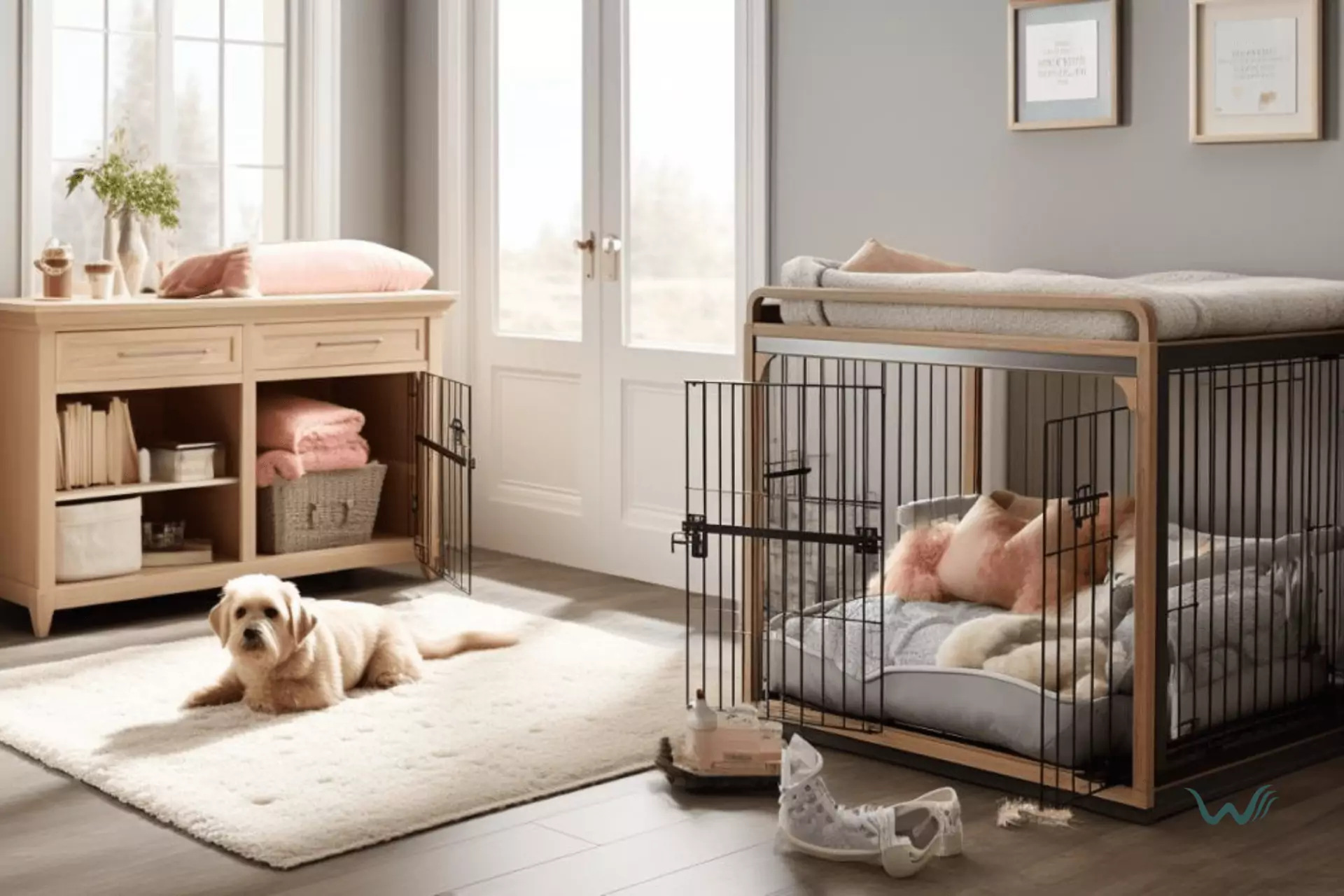

Crate Training Tips For Newly Adopted Pets
by Tayyaba Amir
Last updated: April 23, 2024
Verified and Approved by:
Angela Morris,
MSW, LCSW
Fact Checked

Adopting a furry friend is an exciting and rewarding experience, but it also comes with its fair share of challenges. One of the most important aspects of welcoming your new pet into your home is crate training. Crate training can provide numerous benefits for both you and your pet, and it’s an important step in creating a safe and secure environment for your furry companion.
In this article, we will guide you through crate training tips specifically tailored for newly adopted pets. We will help you understand the benefits of crate training, assist you in choosing the right crate for your pet, and provide valuable insights on how to introduce your pet to the crate.
Additionally, we will help you establish a crate training routine and offer solutions to common crate training challenges. By following these tips, you’ll be able to create a positive and loving environment for your newly adopted pet, ensuring their happiness and well-being in their new forever home.
Key Takeaways
- Gradually introduce the newly adopted pet to the crate, using positive reinforcement and treats.
- Consistency is essential in crate training, including consistent meal times and potty breaks.
- Make the crate a comfortable and inviting space for the pet, with cozy bedding and toys.
- Provide mental and physical stimulation before crating the pet to help alleviate anxiety.
Understanding the Benefits of Crate Training
Crate training provides a safe and secure space for your pet, giving them a sense of comfort and belonging. It acts as their own personal den, where they can retreat to when they need some alone time or when they feel anxious. This can be especially beneficial for newly adopted pets who may be feeling overwhelmed or uncertain in their new environment. By providing them with a crate, you are giving them a familiar and cozy space that they can call their own.
Not only does crate training provide a safe haven for your pet, but it also helps with their potty training. Dogs naturally have an instinct to keep their sleeping area clean, so by using a crate, you are encouraging them to hold their bladder and bowel movements until they are let outside. This helps in establishing a routine and teaching them proper bathroom habits.
Crate training also helps prevent destructive behavior, such as chewing on furniture or getting into things they shouldn’t. When you can’t supervise your pet, placing them in a crate ensures that they are safe and unable to cause any harm. Plus, it helps prevent them from developing separation anxiety as they get used to being alone for short periods of time.
Choosing the Right Crate for Your Pet
When selecting the perfect enclosure for your furry friend, make sure to consider their size and comfort. You want to choose a crate that is large enough for your pet to stand up, turn around, and lie down comfortably. A crate that is too small can make your pet feel cramped and anxious. On the other hand, a crate that is too large can make your pet feel insecure and may lead to accidents inside the crate. It’s important to find the right balance.
In addition to size, you also want to consider the material of the crate. Some pets may prefer a crate made of wire, as it allows for better ventilation and visibility. Others may prefer a crate made of plastic, as it provides a more den-like environment that can make them feel safe and secure. Ultimately, the choice of material will depend on your pet’s preferences and needs. Remember, the goal is to create a space that your pet feels comfortable and relaxed in, so take the time to find the perfect crate for them.
Introducing Your Pet to the Crate
Once your furry friend becomes familiar with their cozy den, they’ll feel safe and secure whenever it’s time for a nap or some alone time. Introducing your pet to the crate is an important step in crate training. Here are some tips to help make the process smooth and stress-free:
- Make it inviting: Place a soft blanket or bed inside the crate to make it comfortable and cozy.
- Add a few of your pet’s favorite toys or treats to entice them to explore the crate.
- Take it slow: Start by leaving the crate door open and allow your pet to sniff and investigate at their own pace.
- Encourage them with praise or treats when they show interest in the crate.
- Positive associations: Associate the crate with positive experiences by feeding your pet their meals near the crate or giving them special treats inside.
- This will help them see the crate as a happy and rewarding place to be.
Establishing a Crate Training Routine
Creating a consistent schedule will help your new furry friend acclimate to their new space and feel secure. Establishing a crate training routine is essential for their overall well-being and happiness. Start by setting specific times for meals, potty breaks, playtime, and rest. This will not only provide structure for your pet but also help them understand what’s expected of them in their crate.
When it comes to crate training, consistency is key. Make sure to take your pet outside for potty breaks at the same times every day. This will help them develop a routine and prevent accidents inside their crate. Schedule regular playtime sessions to burn off excess energy and keep your pet engaged and entertained. A tired pet is more likely to settle down and relax in their crate.
To establish a crate training routine, it’s important to create positive associations with the crate. Make the crate a comfortable and inviting space by adding a soft blanket or bed, along with some toys and treats. Encourage your pet to explore the crate on their own by leaving the door open and placing treats inside. Gradually increase the amount of time they spend in the crate, starting with short periods and gradually working your way up to longer durations.
Troubleshooting Common Crate Training Challenges
Addressing common challenges in crate training can be a key factor in successfully acclimating your newly adopted pet to its new environment. One common challenge is separation anxiety. Your pet may become anxious or distressed when left alone in their crate. To help alleviate this, start by gradually increasing the amount of time your pet spends in their crate. Begin with short periods of time, and gradually extend the duration as they become more comfortable. Additionally, make sure to provide plenty of mental and physical stimulation for your pet before crating them. This can include playtime, walks, or puzzle toys to keep their mind occupied while you are away.
Another common challenge is resistance to entering the crate. Some pets may view the crate as a negative or scary place, and may be reluctant to go inside. To overcome this, try making the crate a positive and rewarding space for your pet. Use treats, toys, or even their favorite blanket to create a comfortable and inviting environment inside the crate. Gradually introduce your pet to the crate by leaving the door open and allowing them to explore it at their own pace. Eventually, they will associate the crate with positive experiences and willingly enter on their own.
Frequently Asked Questions
How long should I leave my newly adopted pet in the crate during the initial training period?
During the initial training period, it’s important to gradually increase the time your newly adopted pet spends in the crate. Start with short intervals and gradually extend them. Pay attention to your pet’s behavior and adjust accordingly.
What should I do if my pet refuses to enter the crate?
If your pet refuses to enter the crate, try making it a positive experience. Use treats or toys to entice them inside, and praise them when they go in. Gradually increase the time they spend inside to build their confidence.
Can I use the crate as a punishment for my pet’s bad behavior?
Using the crate as punishment can create negative associations, making crate training more difficult. Instead, focus on positive reinforcement and reward good behavior. Think of the crate as a cozy den where your pet feels safe and secure.
How can I make my pet feel more comfortable and secure in the crate?
To make your pet feel more comfortable in the crate, try placing their favorite toys or bedding inside. Gradually increase the time they spend in the crate, rewarding them with treats and praise. Consistency and positive reinforcement are key!
What should I do if my pet whines or barks excessively while in the crate?
If your pet whines or barks excessively in the crate, try the u0026quot;treat and retreatu0026quot; method. Distract them with a tasty treat, then gradually increase the time they spend in the crate. Patience and consistency are key!
Certify Your Emotional Support Animal Today

Why You Can Rely on Us?
At Wellness Wag, we believe your pet deserves care rooted in both science and compassion. Each article is carefully researched, written in clear language for pet owners, and then reviewed by qualified professionals to ensure the information is evidence-based, current, and practical for real-life care. Our goal is to help you feel confident in making informed decisions about your pet’s health and well-being.
Reviewed by
Angela Morris, MSW, LCSW
Angela is a licensed clinical social worker with 20 years of experience in patient advocacy and community mental health. She has assisted numerous clients with ESA evaluations and brings a deep understanding of disability accommodations, ensuring that all information is accurate, supportive, and practical.

Written by :
Tayyaba Amir
Last Updated :
April 23, 2024











